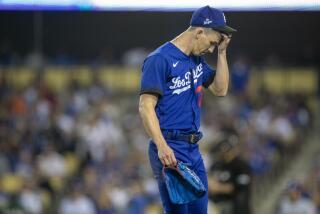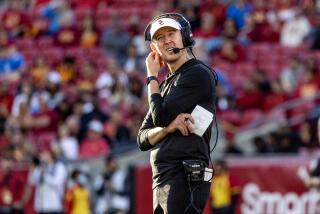Numbers Won’t Figure Into Ryan’s Decision to Play
- Share via
ARLINGTON, Tex. — Nolan Ryan insists that he has never been numbers-oriented, but how does he avoid them?
He is identified and defined by the five no-hitters and 5,018 strikeouts, by the 95 m.p.h. readings on the speed gun, by the two-decade display of ability and durability.
Now, at 42 and approaching the final month of one of his most remarkable seasons, the numbers confronting Ryan are 300 and 1990.
Will he pitch again next year, generating heat at 43?
Is he motivated by the prospect of 300 victories, one last milestone now that he has 284?
The guess is that he will be back.
“We’ll make that decision when this season is over,” Ryan said. “It will be based strictly on how the family feels about it and not any statistical aspect.
“I don’t set goals. Numbers aren’t important.
“If I come back next year with a shot at 300 and am pitching as well as I have this year, that’s when I’ll start thinking about it.
“I came to the Rangers this year not knowing how many innings I could still pitch or how the heat would affect me or how I’d adjust to being back in the American League. It really wasn’t until all those things fell into place that I began to think about 5,000 (strikeouts), that it became a motivation.
“But my only real goal is to help this team win a pennant. The fact that management seems intent on improving the team could be a factor (in whether he returns).”
Ruth Ryan, Nolan’s wife, said the 1989 season has been one of the family’s most enjoyable and that their three children are encouraging their father to continue pitching.
“I think that if he finishes up the way he has been going, he’ll probably pitch again, but that one more year will be it,” she said.
Ryan left the Houston Astros as a free agent after the 1988 season and chose to remain in Texas--he has a ranch in his hometown of Alvin, a Houston suburb--rather than accept Gene Autry’s invitation to return to the Angels.
He is guaranteed $1.8 million in signing bonus and salary this year, and will receive $1.4 million if he returns in 1990. The Rangers hold the option and will definitely exercise it, General Manager Tom Grieve said.
“If I thought it would help to get down on my knees and beg him to return next year, I would,” Grieve said. “He has been everything we hoped for and more. I mean, you run out of ways to compliment the guy. We’ll settle for the one year, but we’re hoping he pitches four or five more.”
Charlie Hough, the Rangers’ veteran knuckleballer, cited Ryan’s performance, inspirational impact and media value, and said: “Signing Nolan was probably the best move this franchise ever made.”
Added Grieve: “It’s impossible to measure the satisfaction and pride that the players, fans and management have experienced merely associating with him, having him here.”
Any yardstick would have to include the following:
--The Rangers’ season-ticket sales increased 1,400 compared to last year, and the average home attendance when Ryan pitches is 30,825, compared to 28,437 when he doesn’t.
--More than 24 years after he threw his first major league pitch, Ryan is averaging 11.3 strikeouts every nine innings, the second-best ratio of his career;has set a single-season club record with 243 strikeouts, his highest total since 1981;has tied another club record with 14 games of 10 or more strikeouts for a total of 195;has restricted opponents to a .189 batting average, the league’s lowest among qualifying pitchers, and is averaging more than seven innings a start.
How does he continue to challenge the calendar and the speed gun?
The question has been asked repeatedly and there is no clear answer.
“I’m baffled,” Grieve said. “I mean, everybody knows that he stays in terrific shape, has great mechanics and is an outstanding competitor.
“But there have been others with those characteristics who didn’t accomplish what he has or didn’t pitch as long. I think there’s an intangible there you can’t put your finger on.”
There’s also a mistaken belief that Ryan, despite his more than 40 major league records, has not been a successful pitcher. The fact is, he has a .524 winning percentage, compared to a .508 for the New York Mets, Angels, Astros and Rangers during the years he was with those teams.
His 3.15 earned-run average is superior to those of several Hall of Fame pitchers.
One who someday is likely to be in the Hall, Jim Palmer, has been critical of Ryan at times for putting too much emphasis on strikeouts, but Palmer said recently:”I’ve had mixed emotions about Nolan because I thought he dwelled on strikeouts too much, but I played on much better teams and didn’t need strikeouts to win.
“Nolan is one of the few pitchers in history who could win a losing game. He did that with strikeouts. He felt he had a better chance of winning, probably his only chance. That’s how he made his money, got his glamour. I can’t imagine anyone getting close to 5,000 again.”
The emphasis on relief pitching and five-man rotations, coupled with the durability and commitment necessary to pitch more than 4,500 innings, lends the strikeout record invulnerability. Mark Langston, among the young strikeout pitchers, would have to fan 300 or more for 13 straight seasons to match it.
The satisfaction, Ryan said, is that it is a reflection of his longevity and preparation, his continuing work ethic at an age, as wife Ruth noted, that many people consider getting out of bed to be a victory.
“Pitching every fifth day controls your whole life,” Ryan said, alluding to training and diet. “I’m never going to go home and say I shortchanged myself or my club.”
There is also satisfaction, he said, in that his continuing success is a reflection of his ability to maintain his velocity. Forget the curve and changeup. Once a power pitcher, always a power pitcher.
“When I lose the fastball, I’m finished,” he said. “But I now believe I’m not going to wake up one moring and not be able to throw hard. I think other factors will affect my ability to go on.”
And how does he react, after the 284 victories and 5,018 strikeouts, to the suggestion that he has put too much emphasis on the speed gun and the strikeouts?
“People have always had the tendency to disregard me as a serious pitcher, someone who has a great knowledge of pitching, but I think that’s a mistake,” he said. “I think I know as much about pitching and more about mechanics than most pitchers because I’ve gone through it for so long and had to battle my control for so long.
“At the same time, I don’t claim to be the best pitcher who ever lived. I’m a strikeout pitcher and have always been a strikeout pitcher. There were times with the Angels when I’d get on a roll and go for strikeouts because I considered the team behind me and felt I had a better chance getting the out that way.
“But when people say I went for strikeouts because they are the most important thing to me, more important even than the win, that’s bull.
“I mean, do you realize how many pitches I’ve thrown, how many times I would have liked to get the out with one rather than the three or four necessary for a strikeout?
“It comes down to the fact that people like to categorize pitchers, but I’ve never started a game thinking I wanted to strike out 10 or 15 batters. Those figures only represent the stuff I had on that particular night. I don’t look on it that I overpowered people. The 10 or more strikeouts tell me I had a good curve and a good changeup and got ahead of hitters. I had a good game because I was able to pitch my type of game.”
More to Read
Go beyond the scoreboard
Get the latest on L.A.'s teams in the daily Sports Report newsletter.
You may occasionally receive promotional content from the Los Angeles Times.






